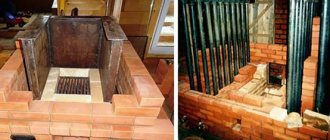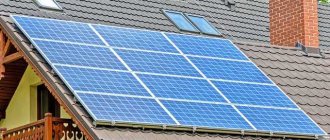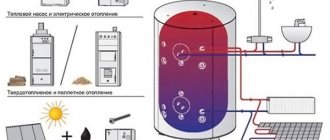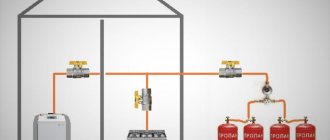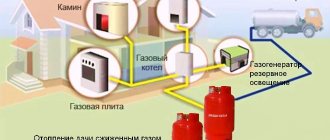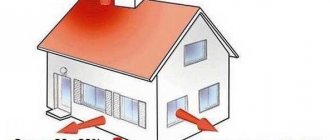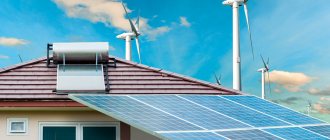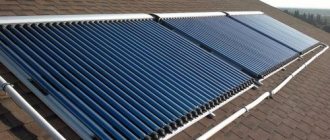Between November and April, in much of our country, the cost of heating a home often exceeds other utility bills. Therefore, even at the stage of designing a home, it is necessary to determine the most economical method of heating a private house. The choice may vary depending on the availability of connection to centralized gas and electricity supply networks, as well as energy prices.
When calculating the total cost of heating, take into account:
- network connection costs;
- the cost of equipment, materials and installation of the heating system;
- energy price;
- depreciation expenses.
Indirect costs, for example, for the construction of a firewood or coal storage facility are included in the cost of utility premises.
Return on investment in reducing heat loss
All consumed heat leaves the house through building structures: floors, walls, ceilings, roofing and windows (doors).
A visual representation of heat loss in a private home.
You can understand how effective thermal insulation is by using heat loss calculators.
Example. A one-story house 6x6 m with a wall height of 3 meters made of expanded clay concrete blocks 40 cm thick, covered with a 20 cm concrete slab. The wall area will be 72 m2, the ceiling area will be 36 m2. The difference between the outside and room temperature is 40 °C (outdoors -20, indoors +20).
Without taking into account windows and doors, heat loss through building structures will be approximately 20 kW (8.7 through the walls and 12.2 through the ceiling).
If you insulate the walls with 100 mm thick polystyrene foam and the ceiling with 50 mm polystyrene foam, then the losses will be reduced to 3 kW (1.4 through the walls and 1.6 through the ceiling).
Even the most approximate calculations show that insulation with modern materials can reduce energy costs by more than 5-7 times.
Replacing one window with an area of 2 m2 with a wooden frame with a two-chamber one made of plastic gives an annual fuel saving of about 350 rubles. On average, it is believed that plastic windows pay for themselves in 8-10 years of operation. Already at the design stage, they plan the placement of rooms, windows and doors, taking into account the cardinal directions.
Conclusion: insulating a house reduces current heating costs several times. The insulation lasts up to 50 years, and the investment pays off in 2-4 years, which is much more effective than saving on the heating system.
Separate heating
Experts advise setting your own temperature regime for each individual room or room. This way you can save a little on heating costs.
For example, in the kitchen you can set the temperature 1-3 degrees lower than in other rooms - the food being prepared and electrical appliances turned on compensates for this difference.
The same goes for bathrooms, storage rooms, and other rooms where you don’t spend a lot of time. Stay indoors for 5-10 minutes. In which the temperature is 2-3 degrees lower than in the rest of the house. Will not cause you any discomfort.
Other ways to improve heating efficiency and economy
If you are only interested in the type of fuel, scroll here. But we think it's good to start with the basics. The fight for efficiency is possible not only through reducing losses, but also in other ways:
- correct choice of type and type of heating;
- compliance with equipment installation rules;
- the use of temperature sensors associated with heating equipment;
- installation of shut-off and control valves;
- installation of energy efficient appliances;
- timely maintenance.
Completing each item can save from 2 to 5% of energy resources, and in total reduce costs by up to 20%.
Types and types of heating systems
A properly selected system allows you to use the selected fuel with the greatest benefit.
A pictorial diagram of a typical single-pipe heating system.
Single-pipe wiring is optimal for small houses with 3-4 radiators in the circuit. A small number of pipes minimizes inefficient heat transfer through their walls.
Diagram of a typical two-pipe heating system in a private house.
Two-pipe wiring ensures uniform heating of all radiators. There is no need to increase the boiler power and energy consumption, since in the farthest room the temperature is maintained at the desired level.
Houses with up to 2 floors and an area of up to 150 m2 can be effectively equipped with a non-volatile gravity-type system that does not require circulation pumps and expensive expansion tanks.
In regions with electricity tariffs that depend on the time of day, it is beneficial to install high-capacity hydraulic accumulators. At night, the boiler heats the water, and after connecting to the daytime tariff, heating occurs for about 2-3 hours due to the circulation of coolant from the hydraulic accumulator.
Rules for installing radiators
Proper placement of radiators allows you to avoid a decrease in heat transfer:
- leave 50-70 mm to the floor;
- to the outer wall from 30 mm;
- to the window sill at least 80 mm.
Exact recommendations are indicated in the device data sheets. Approximate heat transfer losses for various placement options are shown in the figure below.
Changes in the thermal power of the radiator depending on the placement and presence of a screen.
The decrease in temperature is compensated by installing radiators with a large number of sections. The volume of circulating coolant increases, which will require additional fuel to heat up.
Diagonal connection method.
Side connection method.
Bottom connection.
You can increase the efficiency of heat transfer by using diagonal connections of radiators. Side connection reduces heat transfer, but is best suited for gravity systems. Radiators with bottom connections are least effective - this can be considered a “payment” for invisible pipes hidden in the floor or wall.
Temperature sensors
The control units of gas and electric boilers react to the temperature of the coolant, which does not allow timely adjustment of the intensity of work when weather conditions change. Modern boilers allow the connection of remote air temperature sensors in the room, which more objectively reflects the need to increase or decrease the power of the equipment.
A boiler with connected sensors and timers maintains the required temperature at night and when the owners are absent, which also reduces heating costs.
How to choose a room thermostat and save up to 30% per month on heating
Adjustment fittings
With any type of pipe layout and radiator connection, it is possible to change the heat transfer of the device.
Install manual or automatic regulators. This allows some rooms to maintain a lower temperature, which affects energy savings.
Radiator efficiency
Modern radiators have a power of one section from 100 to 210 W. When purchasing, pay attention to this parameter indicated in the device passport. Additional sections are filled with coolant, which will have to be heated and moved through pipes using a more powerful circulation pump, which increases costs.
Heat transfer from heating radiators Comparison of indicators and calculation methods
Maintenance
The formation of calcium deposits on the internal walls of the heat exchanger and radiators reduces the efficiency of the equipment.
It is important to use clean, soft water or antifreeze recommended by the heating equipment manufacturer. It is necessary to monitor the condition of the coarse and fine coolant filters, as well as the purity of the water (antifreeze).
How to choose a water softener for a gas boiler and extend the life of the heat exchanger
Modern economical technologies
This technology includes a heat pump.
With the help of earthly resources, it is capable of producing at least 4 times more energy than it consumes itself. If you need a boiler for your home with a power of 20 kW, then a heat pump with a power of only 5 kW will be suitable for heating. The heat pump runs on electricity. The pump also costs 3-4 times more than a first-class gas boiler with high efficiency. Solar collectors can be used for heating. There is no energy consumption required at all. When properly installed, solar collectors can heat heated floors and provide you with the necessary amount of hot water. But again, it all comes down to finances.
Our future lies in these technologies. The moment will come when both a heat pump and a solar collector will become available to everyone.
As a result, we get that using a warm floor + temperature control + a heat pump (or collector) we can get truly the most economical home heating.
If you are looking far ahead and are confident that you can afford such expenses, then you definitely will not regret having all this installed at home.
Common heating system options
Traditional types of fuel are:
- wood: firewood, pallets, sawdust and chips;
- coal of various types;
- natural gas (from a centralized pipeline);
- liquefied gas in cylinders or gas tank storage;
- electricity.
Table. Calorific value of various types of fuel.
| Fuel | Unit | Specific heat, kcal | Released thermal power, kW | Compliance with 1m3 of natural gas | Cost of fuel to produce 1 kW of energy, rub. |
| Electricity | 1 kW/h | 864 | 1,0 | 0,11 | 2,8–5,6 |
| Natural gas | 1 m3 | 8000 | 9,3 | — | 0,8 |
| Liquefied gas | 1 kg | 10800 | 12,5 | 1,35 | 2,3 |
| Coals: hard, anthracite, charcoal | 1 kg | About 6500 | 7,5 | 0,8 | 1,4 |
| Brown coal | 1 kg | 3100 | 3,5 | 0,4 | 1,8 |
| Peat | 1 kg | 2500–4200 | 3,0–4,9 | 0,3–0,5 | 1,8–2,5 |
| Firewood | 1 | 1800–4000 | 2,2–4,8 | 0,25–0,6 | 1,3–1,8 |
| Pallets, granules | 1 kg | 3400–4300 | 3,7–5,0 | 0,4–0,6 | 1,5–1,9 |
The cost may vary depending on the tariffs in force in the region and the price of fuel purchased from private suppliers, as well as the efficiency of a specific boiler model.
The cheapest fuel is mains gas, the most inefficient from an economic point of view is electricity.
Renewable heat sources
When calculating the costs in detail with heat pumps, wind turbines, solar collectors and batteries, the situation looks like this. They generate heat and electricity for a private home, but at first glance it is free. Of course, the sun and wind do not bill for heating, but such generation equipment is very expensive.
In Europe, renewable energy is sometimes subsidized from the state budget. Plus, the price tag for fossil fuels is frankly stinging. Therefore, “green technologies” there are economically justified and relatively effective.
In Russia the situation is radically different. Our state is not yet going to subsidize alternative energy. And prices for domestic firewood, coal and gas, compared to their neighbors in the west, are not so high.
As a result, based on the totality of all costs, it is difficult to call heat pumps, solar panels and wind turbines particularly economical. They generally show their effectiveness only in remote areas where it is difficult and expensive to deliver burned fuel.
The most economical heating method remains a gas boiler
Modern wall-mounted models can also be placed in a kitchen cabinet, completely hiding it from view.
High calorific value and low price make main gas an optimal fuel.
The advantage of installing gas boilers will only increase if the Presidential Order on free gas pipeline installation to individual areas is implemented.
Table. Advantages and disadvantages of gas boilers.
| Advantages | Flaws |
| Low price | Strict requirements for the combustion room |
| Possibility of connecting different heating schemes: gravity and forced, vertical and horizontal, one- and two-pipe | Mandatory paid technical maintenance in a specialized organization |
| Availability of electrically independent models | Difficulties in ensuring the removal of combustion products and the supply of combustion air |
| Interchangeability, availability of spare parts | |
| Wide range of models: floor-mounted or wall-mounted, single- or double-circuit with heating of sanitary water, various powers, with a closed or open combustion chamber, convection and condenser | |
| Presence of Gazprom operating organizations in every locality |
Gas boilers with a capacity of 24 kW cost from 35 thousand rubles. Such equipment heats and supplies houses with an area of up to 150-180 m2, which are in demand by families of 3-4 people.
In areas without a centralized gas pipeline, an individual or group gas tank is installed. Equipment and installation will cost about 70 thousand rubles per 1 m3 of storage. Heating an insulated house of 150 m2 will require consumption of about 4.5 tons of fuel per year. Refueling is usually carried out 2 times a year, so choose a capacity of 2.5-3 m3.
The price of a complete set of equipment will be about 150 thousand rubles, and installation costs from 100 thousand rubles.
For natural or liquefied gas, the same boiler models are used, only the types of nozzles are replaced.
Efficient gas boilers
In areas with frequent power outages, preference is given to non-volatile boilers. The automation unit is built on the basis of a thermocouple. While the wick is burning, the gas supply valve to the burners is open. If the gas is turned off, the wick will go out, the valve will shut off the supply, and the boiler will turn off. Restarting is only possible in manual mode.
The main part of the front panel of an electrically independent gas boiler.
Attention! Non-volatile boilers are used only in gravity systems or in case of reliable backup of the power supply to the circulation pump.
Boilers with an electronic control circuit turn off when there is a loss of gas or electricity in the network and automatically turn on when the power supply is restored, they are safe, and the heating circuit can be constructed by any means.
The efficiency of most gas boilers is in the range of 80-94%. Considering the same schemes for constructing automatic boilers, we should talk not about efficiency, but about the price/quality ratio - how long the equipment will last and how expensive repairs will be.
The most famous manufacturers of high-quality gas boilers:
- Vaillant;
- Bosch;
- Protherm;
- BAXI;
- Viessmann;
- Buderus;
- Siberia;
- Lemax.
The equipment is built according to a single functional scheme and often uses the same components - heat exchangers, circulation pumps, gas valves. When choosing, pay attention to the possibility of warranty service and repairs near your place of residence.
In recent years, marketers and manufacturers have been focusing on advertising condensing boilers, which are 2.5-3 times more expensive than conventional convection boilers.
Differences and selection criteria for condensing gas boilers. Details about operating conditions, requirements for CO and chimney
For your information! Convection boilers are conventional gas boilers in which the heat exchanger is located above the burner, and according to the laws of physics, the flame rises upward, heating the coolant flow.
The statement that the efficiency of a condensing boiler is more than 100% is nothing more than an advertising ploy. The operating principle is based on the fact that combustion products are returned to the heat exchanger by means of a fan, where condensation occurs.
The results of the measurements indicate that the efficiency of the boiler due to condensation can be increased by no more than 3-5%. Considering the difference in price by one and a half, the payback period for boilers with a power below 30 kW should be expected in 7-10 years. At this point it is time to replace the boiler. Units with a power above 40 kW pay for themselves in 4-5 years, in this case such a purchase is profitable.
Pellets
Pellets are granules that, like briquettes, are pressed from wood waste. To use them you need a special boiler. Such equipment is equipped with a hopper for loading pellets, and automation, which is responsible for dosing their supply into the combustion chamber. In principle, in terms of ease of use, this fuel is better than firewood, briquettes and coal.
However, there are a number of nuances. Firstly, pellet boilers are relatively expensive. Secondly, the fuel itself is still expensive, even though it is made from waste. Thirdly, pellet boilers are bulky.
Conclusion. In terms of convenience, pellets, of course, are inferior to natural gas and electricity. In some respects, this type of heating is better than wood and coal. But there are a number of factors due to which this type of fuel is not very popular among the mass user.
Solid fuel
Coal.
Solid fuels include:
- wood;
- different types of coal;
- waste from wood processing and agricultural enterprises.
Solid fuel is burned to produce heat. Direct heating does not imply the use of an intermediate coolant; in the case of installing solid fuel boilers, heating systems with radiators are installed.
Stoves, fireplaces, potbelly stoves
It is advisable to consider stoves as the main heating system when building rarely visited country houses or bathhouses.
| Advantages | Flaws |
| Minimum equipment price | Rapid fuel burnout |
| Instant heat release from steel stoves and fireplaces after ignition | High cost of stone stoves |
| Long heating of brick or stone walls | |
| Low efficiency: 30% for potbelly stoves, 60% for the best stove models | |
| The need to arrange fuel storage areas | |
| Fire hazard of stoves and woodburners | |
| Danger of carbon monoxide poisoning | |
| Heating no more than 2-3 rooms |
The best options for heating stoves are of the bell-type type, when hot air passes several times through the smoke channels and is collected under a kind of hood.
Bell type furnace.
Steel stoves are chosen based on the same criteria: the gases must burn completely after passing through several smoke channels.
Solid fuel boilers with manual operation
Cutaway view of a modern Teplodar Kupper coal boiler.
The use of wood or coal boilers is recommended in areas where it is impossible to connect to a centralized gas supply or where it is not possible to equip a gas holder.
Table. Advantages and disadvantages of heating with wood and coal boilers.
| Advantages | Flaws |
| Fuel of any quality is suitable | Instability of calorific value - depends on the moisture content of the fuel, type of coal, type of wood, difficulty in calculating the fuel required for the season |
| Complete independence from power supply when installing a gravity system | Requires constant monitoring and maintenance - loading fuel, removing ash |
| Low price of 1 kW of energy | Low average efficiency |
| Possibility to use free or cheap wood processing waste (often wane can be removed for free, paying only for transport services) | Cooling of radiators with high hot water consumption (in double-circuit boilers) |
| Availability of automated boilers with adjustable combustion speed and supply of pallets or granules | Fire hazard in fuel storage areas |
| Difficulties in organizing a “warm floor” system |
The price of the most popular boilers with a capacity of 14-20 kW ranges from 25 to 70 thousand rubles.
Advice! To maintain the temperature of the coolant at night and during the day, when the owners are absent, they purchase boilers with built-in electric heating elements, which turn on when the fuel burns out and the temperature drops.
Justification for the purchase of high-tech solid fuel boilers
In an effort to increase efficiency, manufacturers resort to various technical solutions:
- create conditions for complete combustion of fuel;
- air charging fans are built into the design to ensure fast or slow combustion;
- install automatic dampers that reduce the air supply when the coolant is overheated.
This is what a pre-installed air charge fan looks like.
Automatic damper on a TT boiler.
Pyrolysis is the separation from fuel by heating it of gases that burn at high temperatures. The process requires precise stabilization of the operating mode.
The operating principle of pyrolysis coal boilers using the Geyser VP model as an example.
It is technologically difficult to achieve the effect in boilers less than 50 kW, but this power is enough to heat a house up to 500 m2.
The offered boilers up to 50 kW can only conditionally be called pyrolysis. Usually these are two-chamber devices. In the first chamber, direct combustion of wood (coal) occurs, and the second is an afterburning chamber, where the remaining organic substances are burned.
The price of such boilers is 2-3 times higher than usual, so part of the profit received by the manufacturer can be used for advertising.
Important! The purchase of so-called “pyrolysis” boilers of low power (up to 40 kW) allows you to increase the efficiency of installations by 5-20%, but you will have to pay 2.5-3 times the cost for the equipment.
In order to talk about the payback of high-tech pyrolysis boilers relative to conventional ones (direct combustion), it is necessary to calculate the costs incurred.
Example. To heat the house, a 25 kW boiler is required. A direct combustion device costs about 35 thousand rubles, a “pyrolysis” device costs about 90 thousand.
For example, the consumption of firewood in a regular boiler per season will be about 20,000, in a “pyrolysis” boiler it is 5-10% less, i.e. 18–18.6 thousand rubles. The savings will be 1.4–2.0 thousand rubles. Boilers up to 25 kW must be equipped with a fan with a power of 50 W or more, which will consume 800–900 rubles worth of electricity per season. Thus, the net benefit from installing a long-burning boiler will be no more than 1000 rubles per season; we can talk about payback in 30-40 years.
Payback of truly pyrolysis boilers within 10-15 years of operation is possible with equipment power of 40 kW; in such devices, combustion efficiency can be increased by 20%.
Efficiency and selection criteria for modern pyrolysis solid fuel boilers
The best manufacturers of solid fuel boilers
Solid fuel boilers are produced by many brands. Based on the number of sales and user reviews, the following companies' products stand out:
- Teplodar;
- Rommer;
- TMF;
- Zota;
- Heiztechnik;
- Thermocraft.
The choice is made according to the required power and available fuel.
Liquefied gas
In terms of cost per kilowatt of energy, liquefied gas ranks third.
There are different ways to deliver and store it, but the smaller the volume, the more expensive the final price. Therefore, a gas holder is needed for a permanent home, and for a small dacha, which is rarely visited in cold weather, you can get by with several 50-liter cylinders. When using a gas holder, the price of a kilowatt of heat from burning liquefied gas is 2.3-2.5 rubles, the use of cylinders raises the bar by 50 kopecks.
You can also heat yourself in different ways.
The simplest system is direct combustion of gas to produce heat without heating the intermediate coolant, pipework and radiators. For this purpose, gas convectors and infrared heaters are used. Their operating principle and design are different, but they have one thing in common - availability of equipment, compactness and operation from bottled gas. The disadvantage is the power limitation and heating of only one room. For example, infrared and catalytic gas heaters from AYGAZ have a maximum power of 6.2 kW.
With such a compact infrared heater you can heat up to 40 m2 Source vps-region.ru
On a note! You can get professional advice on autonomous gasification of a private home directly from specialists
The gas tank allows you to build a full-fledged autonomous water heating system, and the frequency of refilling depends on the volume of the container, heating area and operating mode. In terms of ease of operation and maintenance, the system ranks second after electric heating. But it requires significant initial investment for the purchase of a gas tank, its installation (usually underground) and the laying of communications (pipes for connection to the boiler and electrical cable for the tank heating system).
Another difficulty for a gas tank is choosing a location. It should be located close enough to the house and be accessible for gas refilling Source rosavtonomgaz.ru
Electricity for heating the house
The most expensive and cost-ineffective heating method is the use of electricity to directly heat the air or using an electric boiler.
Classic heating element electric boilers are compact in size and can be installed in any room. They already contain in their housing all the necessary elements of the heating system (circulation pump, expansion tank, safety group), which greatly simplifies installation.
Table. Advantages and disadvantages of electric heating.
| Advantages | Flaws |
| Does not require approval or a service contract; it is enough to obtain permission for the required power of electrical installations | Not suitable for houses with an area of more than 120-150 m2 - the energy supply organization does not approve power above 15 kW |
| Easy installation, inexpensive components | The highest cost of 1 kW of heat (up to 10 times more than gas systems) |
| High efficiency - up to 99% of energy is released as heat | |
| Variety of designs - convectors (oil, quartz), infrared emitters, halogen heaters, fan heaters, electric boilers with a water heating circuit | |
| Easy to maintain the selected temperature throughout the day and for several days | |
| Long service life - up to 50 years for convectors |
In an effort to increase the efficiency of electric heating, manufacturers have developed heating methods and methods for saving energy that are considered innovative for our country.
Geothermal pumps
You can learn more about the operating principle of a geothermal pump in a separate article.
The method uses heating of the coolant from the ground or water, due to which the heat transfer is 200-500% of the used compressor power. This makes monthly costs comparable to heating with wood and only slightly higher than using gas.
The advantage of this method is low energy costs. The main drawback that limits its use is the high initial costs for components and installation, reaching from 300 thousand to 1.5 million rubles.
The efficiency of geothermal pumps in frosts from 25 ° C sharply decreases, falling below 90%. In this case, to maintain a comfortable temperature, electric heating is turned on using boilers, convectors or infrared emitters.
Summarizing all of the above
Weighing all the pros and cons, all the pros and cons, we can definitely say the following: if the house was purchased with gas heating already connected, then of course it is not worth changing it.
If you are not ready to invest almost a million rubles in your house so that it has gas, and the speed of heating the rooms is also important to you (in this regard, gas heating loses to electric heating), it is better to give preference to electric heating.
The fact is that electrical systems do not have this drawback, especially if you use a boiler-air system. The whole trick of quick warming up is convection - room air is taken in by the system, then heated and returned to the room, taken in again, and so on in a circle. Such systems are characterized by very high efficiency - and produce more heat than they consume energy.
Free access
When using a radiator or convector heating system, certain rules must be followed.
Never cover radiators and convectors with furniture or curtains. They will obstruct the flow of infrared radiation from the heating device. Due to this, heating efficiency can drop by 40-60%!
Do not install continuous decorative screens on batteries. They will also interfere with efficient heating of the house and natural air circulation.
If you are just planning to make a radiator heating system. make sure that batteries are placed where they are needed in compliance with all regulations. Correct installation of heating radiators will save up to 20% on home heating costs!
Poison the air!
Air pockets can form in radiators and heated floors over time. They impair the efficiency of the heating system and increase the consumption of gas, electricity and other energy carriers.
Immediately after starting the heating system, check how efficiently it works. Try bleeding air from radiators or heated floors. Read more about that. Read how to do this in the articles “How to remove air from a warm water floor” and “How to properly bleed air from a heating radiator.”
If you have radiator heating, do not forget to check it at least once a month. Pay attention to how efficiently radiators heat. is there a temperature difference in their lower and upper parts.
Solid fuel boilers with heat accumulator
A standard solid fuel boiler can also be made quite economical by equipping it with a heat accumulator. The device of this design looks simple: the battery is an insulated container with pipes for connection to the heating system. The heat accumulator, as its name implies, accumulates the thermal energy generated by heating equipment.
The efficiency of the storage device largely depends on its volume - for example, a 3000-liter battery that has accumulated a sufficient amount of energy can independently heat a house of 90 m2 throughout the day. The battery tank acts as a kind of jumper between the boiler and heating devices.
Why electric heaters?
You will immediately ask yourself why classic water or stove heating of rooms is not considered? The answer is simple - this is due to the fact that installation work and maintenance for approximately the same money will be reduced to a minimum.
Now we will provide several reasons why it is obvious that the best and most economical heating system for a private home is electric.
- Electric heaters are silent, do not require additional resources (coal, firewood, liquid fuel) and do not pollute the atmosphere. This means that in a private house there is no need to have space in the utility room for fuel, make a chimney, and also remove soot every year. All you need to do is connect the system to the network and enjoy the warmth.
- Installing an entire electric heating system does not require a huge upfront cash investment. For example, installation of a water heating main is carried out once. A project is created, all pipes, radiators, a boiler, as well as additional automation are purchased. You will not be able to complete part of the work (for example, in one room), and if you have money, you will not be able to complete the project over time, and if you succeed, many problems will arise. It will be necessary to drain the water, cut into the finished highway, etc. In the case of electric heaters, everything is much simpler. You can install equipment in each room separately as you earn money. At the end of spring, buy convectors for the bedroom, later - for the kitchen, bathroom, etc.
- Today there are many ways to save on energy consumption. Of course, this option requires considerable expenses, but rest assured, over time they will pay for themselves. The installation of economical two-tariff meters, as well as solar panels on the roof of the house, is popular.
- You can connect a boiler, boiler or even a convector yourself, significantly saving money on calling a technician.
As you can see, electric heating in a private home really outperforms alternative options, so installing such a system is quite profitable.
Homemade economical electric battery heating system
